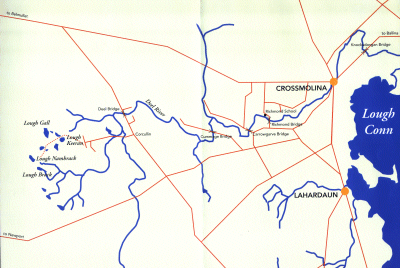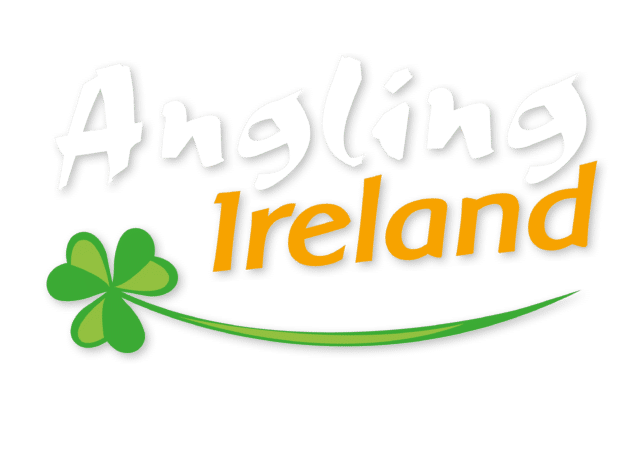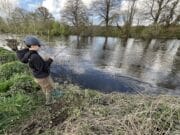The Owengarve, Mullaghanoe and Sonnagh Rivers
These are relatively small rivers ( 4 to 6 m in width) all of which enter the upper part of the main Moy channel in the Bellanacurra area from a south easterly direction. They all hold excellent stocks of wild brown trout from a few ounces up to 1 ½ lbs. They have prolific hatches of small mayflies, stoneflies and sedges. Wetflies, dryflies or nymphs are likely to produce lively fishing at any time of the season.
The Owengarve or Curry River is the largest of these three rivers, rising in the low lying peatlands of east Mayo, flowing through a mixture of farmland and bog through the village of Curry, Co Sligo, before joining the Moy. The banks are high in some places but styles and footbridges have been constructed making most of the best fishing areas reasonably accessible. The best of the fishing is in the three mile stretch from Curry downstream to Dawros Br., where there are some excellent stocks of trout averaging ½ lb with some to 1½lb.
The Mullaghanoe River rises near Knock Airport and flows in a northwesterly direction through Charlestown to join the Moy channel just downstream of Bellanacurra Bridge. It holds excellent stocks of trout to 1 lb although the average size is slightly smaller than the trout on the Owengarve. The best fishing water is from
The Sonnagh is the smallest of these three rivers being little more than 3 – 4m wide in most places. It is a lively stream and has some lovely runs and pools. The trout are small here, a half pounder would be considered a good fish, but some of the deeper pools can produce something larger to a well sunk nymph. It is a very attractive little river, particularly around the Cloontubbrid area. It is located in a quiet, rural setting and can produce lively fishing on light tackle.
The Clydagh, Castlebar, and Manulla Rivers.
These are quite different rivers which converge in the Turlough/Bellavary area and flow into the southern end of Lough Cullin. They offer some of the best brown trout river fishing in the north western region and produce up to two hundred spring salmon on rod and line annually.
The Castlebar River originates in the Castlebar lakes. It is a rich limestone river and, because of its lake source, it rarely runs low in summer. Trout Fishing is good throughout its entire length with fish averaging one to two pounds and occasionally reaching four pounds. It can be particularly good for dry fly fishing on summer evenings.
The Clydagh River rises east of the Nephin Beg range and is the spatiest of these three rivers. The trout are numerous but generally quite small. There is some good spring salmon fishing in the lower reaches but the river is quite overgrown around Carrowkeel.
The Manulla River rises in the rich limestone plains of east Mayo and, while its upper reaches have a low gradient, there are nice riffle and pool sequences downstream from Moyhenna Bridge which offer good trout fishing. Of all the Moy tributaries, it is the one which most resembles a chalkstream with deep clear pools which hold heavy trout. On a mild summer evening, this river can offer excellent dry Fly fishing to the experienced angler.
The lower end of this river is a salmon fishery, managed under licence by the Ballyvarry Fishery. Day tickets are available from Tiernans in Foxford, salmon licence required.

The River Deel
The River Deel rises high in the Nephin Beg mountains and flows for twenty eight miles through moorland and pastures, and through the town of Crossmolina, before entering the northern end of Lough Conn. It is the largest of the Moy tributaries and offers a wide variety of angling experiences ranging from dry fly fishing for trout in the lower reaches, to lively brown trout fishing in the remote upper reaches.
The River Deel also offers good trout angling with dry fly, wet fly and nymphs. Generally the trout are of small average size but a one or two pound Fish is a real possibility.

Trout fishing on the Rivers Gweestion, Pollagh and Glore
These three rivers rise in the Mayo/Roscommon border region, an area of rich limestone plains and raised peatlands. They are all highly alkaline rivers with an abundance of insect and crustacean life which support excellent stocks of wild brown trout. These stretches of river offer the chance of fishing in solitude for trout which may never have seen an artificial fly, Some of the better angling areas have had development work carried out to improve access and to create deep pools where large fish can find shelter. In the more remote areas, the banks can be traversed but are undeveloped.
The Pollagh and Glore Rivers converge about three miles south east of Bohola to form the Gweestion River. This has a substantial channel, up to fifteen meters wide in places. It has a lot of shallow streamy water but some good pools have been created during the recent angling development programme. Consequently, there are large stocks of small trout as well as good numbers of better fish; occasionally, trout up to three pounds are caught here. Towards the end of the season, this river may also produce some grilse.
The Pollagh River is the larger of the two tributaries which join to form the Gweestion. The river is composed of a nice mixture of pools and riffles which can be fished with either wet or dry fly. There is an excellent stock of trout between half and three-quarters of a pound and plenty between one and two pounds.
The Glore River is the smallest of these three rivers and is mainly suitable for wet fly fishing. It is gin clear, and about six to eight meters wide. Most of the trout are from a quarter to three-quarters of a pound, but the occasional fish up to two pounds is also caught.
For further details contact the Board’s Angling Officer.








